We have a biological clock which determines the operation of our organism according to the cycle of day and night. During the day we are awake and active to perform normal activities and at night, the body relaxes leading us to a state of drowsiness preparing us to rest.
This cycle of day and night synchronizes our biological clock determining what is called circadian rhythm.
The welfare of the people and even their health are influenced by this rhythm. Our bodies need to keep pace in order to have a normal life.
However, with technology we are changing this pace and with it important changes begin to be noticed in those who are directly affected by the non-observance of this rate.
While we can mention as an example the people who exchange the day for the night in their professional activities, there are other factors which must be taken into account and that even need to be considered by the authorities who take care of our health.
Light is Important
According to studies in several universities, the responsibility for the perception of the changes between day and night is in the cells of our eyes that recognize the blue light.
These studies also show that the light temperature above 5 000º K suppresses the production of melatonin (MLT) which is a hormone produced at night which regulates the circadian rhythm in the body.
According to what is claimed the exposition to radiation which corresponds to this temperature causes the reduction of melatonin (MLT) makes the organism sensitive to breast cancer, colorectal cancer and prostate cancer.
When the light temperature falls below 2 000º K the reduction of hazards are even greater.
Light Temperature - What it means
The ideal emitter of light is a black body that when heated produces radiation spreading the magnetic spectrum.
Thus, if we consider a black body, as it is heated, the transmitter spectrum will be shifting with peaks increasingly tending to shorter wavelengths and therefore the predominant color we see this issue.
A cooler body emits a light with the predominance of red, tending to blue as the temperature rises.
All this can be displayed in a graphic that we owe to Stefan-Boltzmann, and that is shown in Figure 1.
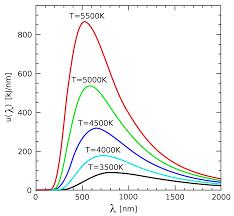
Note that the "hotter" the body is, the higher the level of radiation in the range of shorter wavelengths, which correspond precisely to the blue color.
Returning to Our Circadian Rhythm
The main sensor which informs us about the changes between day and night, synchronizing our biological clock is a light sensor that is precisely based on the wavelengths of blue radiation.
Apparently this is due to the fact that the presence of blue light is directly related to the day, because as the sun sets, for example, the intensity of blue light is the one which decreases faster.
In the twilight the sky becomes gradually yellow and then red, initially cutting the radiation of shorter wavelength, i.e., starting from the blue.
With artificial lighting available, the effects of changes in the circadian rhythm have not become important for the simple reason that the candle light and after incandescent lamps is poor in radiation of short wavelength, as shown in the emission curve of Figure 2. In it we also have the emission curve of white LEDs.
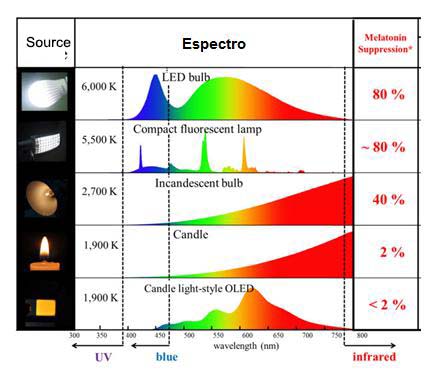
Thus, the candle light, lamps and incandescent lamps, do not make our sensors associate their light to the day, and the drowsiness of the night remains.
This type of light does not help keep us awake, precisely because of the lack of blue.
However, we are going through a transition, in which the energy saving light bulb (gas) and the fluorescent lamp already contain a reasonable component of blue, interfering with the circadian rhythm and now more dangerous than the LEDs.
In the Figure 2 graph shows the amount of melatonin that is suppressed when we are exposed to many types of light sources;
But what worries us is that the night light of the cities is growing at an uncontrollable pace as well as the use of common LED lamps.
For example, a map of the lighting of cities made by a researcher and shown in Figure 3 shows that in some parts of the world, urban light is so much that you cannot see the night sky.
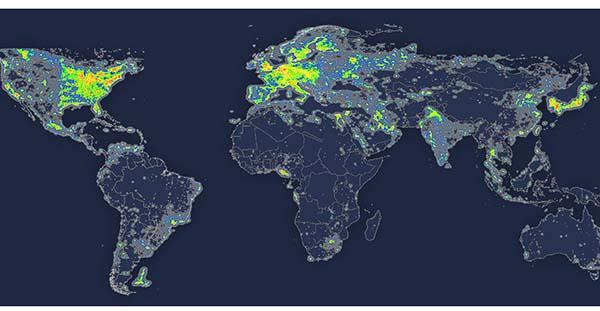
This same researcher shows that only in a few regions of the world you can see the Milky Way at night and in most cities only the stars of higher brightness and planets like Jupiter, Venus and Mars can be seen at night, as shown in Figure 4. In this map we have the sky visibility in a city, in the suburbs, going to the region of darker sky in remote rural areas.
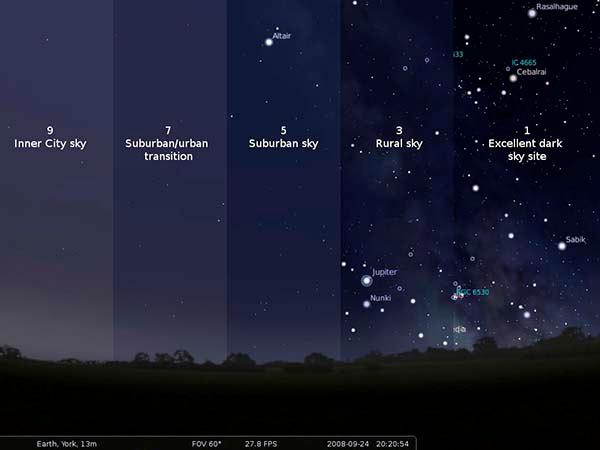
All this could only mean that at night in these cities would be lighter with more light, without affecting us on if the lighting did not have a dangerous blue component that is increasing.
Back in the days when lighting was only ordinary incandescent bulbs that really occurred and there was no danger.
However, many cities are changing the streetlights and billboards to LED lamps.
We were in New York recently (2016) and we personally saw what happens. In Figure 5 we have a picture of the Times Square at night.
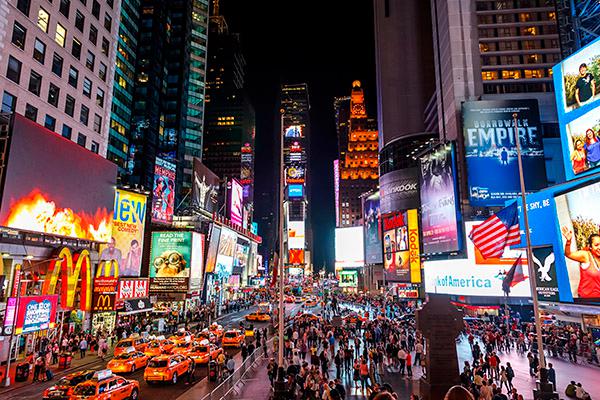
The streets of New York also began to have LED lighting and the lights of the central region (Timer Square and Broadway) are extremely strong. We had problems at our hotel on Seventh Avenue that even with the drown curtains still received too much light at night.
Since this light has a strong blue component, the effects on the circadian rhythm appear. There is no drowsiness in New York at night!
Apparently the lyrics of the song New York, New York immortalized by Frank Sinatra when he says the "city never sleeps" really seems like, more than ever, is becoming a reality, now with LED lighting.
But it is not only the circadian rhythm that is affected by the presence of the blue component of light.
It has been found by researchers that the change of pace, induced by the presence of blue light and undue times can even cause illness, with researchers who are even linking it to certain types of cancer, as we said earlier in this article.
The problem may be more serious than we think. The beauty of the night lights of a city, or even from a room we go, needs to be analyzed more carefully.
Attention to Health
As we saw, the presence of the blue component in the night lighting should be considered carefully both by us and by the authorities.
For example, one should consider that the ambient lighting of residences in environments we want to maintain the normal circadian rhythm, without affecting our well-being and exposing us to the most serious problems, should have the blue component reduced.
Maybe the insomnia in some people is due to the presence of this component. Something that should be studied.
Thus, lamps with smaller blue components must be considered. Some LEDs already offer this possibility. They are those in which the "temperature" of the light is lower.
They are the lamps of OLEDs (organic LEDs) whose temperature of light emitted is the same as a candle, i.e., about 1900° C not inhibiting the production of melatonin. In Figure 6 the structure of an OLED.
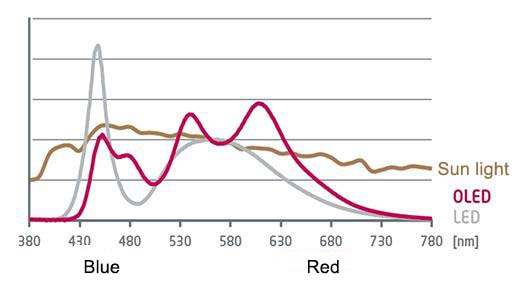
A light slightly "yellowish" in the room, with less blue component is healthier than the bright white light that has a more intense blue component.
Similarly, this factor must be considered in the illumination of public places, for example, the streets.
Something to be analyzed by the authorities when there is determined the type of lamp to be used in certain applications and even put warning labels on lamps, indicating its proper use.
Of course that further studies should be carried out and with it verify the extent to which light pollution affects us.




